This article was co-authored by Christopher Taylor, PhD. Christopher Taylor is an Adjunct Assistant Professor of English at Austin Community College in Texas. He received his PhD in English Literature and Medieval Studies from the University of Texas at Austin in 2014.
wikiHow marks an article as reader-approved once it receives enough positive feedback. In this case, 89% of readers who voted found the article helpful, earning it our reader-approved status.
This article has been viewed 85,486 times.
Oh no! You either procrastinated, got super busy, or forgot your research paper was due tomorrow. In either case, you’ll have to work fast and use a lot of online resources to help you finish it quickly.
Steps
Brainstorming a Research Topic Quickly
-
1Read the prompt your teacher or professor gave you. Before you pick a topic, you will want to be sure that it fits within the confines of the assignment. Read the instructions very carefully; you don’t want to waste time writing something and then find out that it doesn’t fit the assignment.
- Imagine that this is your prompt: “Though virtually every 19th century woman did domestic work inside the home, many also labored outside of their homes. Choose an occupation that American women frequently held in the 19th century. Write an 8-10 page research paper about this occupation.”
- Take note of the particular confines of the research paper. For example, you can only write about women’s work, and you must stick with a job American women held in the 1800s.
-
2Brainstorm a list of possible topics for your research paper. [1] Think about the topics you already know a little about from class or personal interest. Your list of possible topics for a paper on 19th century women’s labor might look like this:
- teacher
- midwife
- innkeeper
- seamstress
- factory laborer
Advertisement -
3Do a quick Google search on each of your topics. If any of them return very few results, cross them off your list. You won’t have time to track down sources for a difficult topic, so go with one that returns lots of hits.
- Be sure that a lot of your hits return results from credible sources. Look for sites that end in .edu or .gov. [2]
- Check to see if a Google search returns any books on your topic. Odds are good that you’ll be able to find at least part of the book (or a book review) online, so this will help you later.
-
4Select the topic of your research paper. Pick a topic that returned a lot of credible hits on Google, and, if possible, also interests you.
- Let’s imagine that you chose midwives as the topic of your paper on 19th century women’s labor. This topic returned a lot of hits from university and government sources, and there appear to be lots of books about 19th century American midwifery.
-
5Write a preliminary outline of subtopics. It’s a good idea to write a simple outline before you get too far into your research. This will help you form more in-depth searches.[3] Odds are good that you will have to alter the outline as you go, but that’s okay. You may want to include some questions that you have about your topic in your preliminary outline.
- You will probably want one subtopic for roughly every 2-3 pages.
- So for a 10 page paper, try to think of at least 3-4 subtopics. It’s okay to have too many or too few at this stage.
- Your outline on 19th century midwifery may look something like this:
- Demographics - Which women were midwives? (Age? Race? Class?)
- Payment - Did people pay them cash?
- Daily life - Did midwives have other responsibilities beyond childbirth? What did their daily lives consist of?
- Laws - Legality of midwifery?
- Qualifications - How did a person get to be a midwife?
- Stats - How many women were midwives?
- You will probably want one subtopic for roughly every 2-3 pages.
Doing Research Online in a Time Crunch
-
1Decide how you will organize your research as you go. Especially since you’re in a hurry, you don’t want to have to waste valuable minutes trying to find a website you saw an hour ago. Choose an organization system that works well for you. Consider:
- Bookmarking the websites on your browser of choice
- Copy and pasting links into a Word or Google document (which you can later turn into a Bibliography)
- Using a research organization tool such as Zotero (or any other site that keeps track of sources and creates Bibliographies)
-
2Do a Google search on the first subtopic. Be sure to try various ways of phrasing it.
- For example, if you want to find out about midwife demographics first, there are a variety of ways you might accomplish this. You might search variations on any of the following:
- ”19th century midwife demographics”
- ”how old were most 19th century midwives?”
- ”19th century midwives, race”
- For example, if you want to find out about midwife demographics first, there are a variety of ways you might accomplish this. You might search variations on any of the following:
-
3Save the most relevant web pages that Google returns. At this point, you should just skim them for relevance to your topic. You will look at them more carefully as you start to write.[4]
- Don’t spend more than one minute on each page. If you’re fairly certain that it contains information that can help you, save it, and move on.
- For example, if your search “19th century midwife demographics” returned a chart from a university website organizing midwives by age, race, class, and location, you do not need to read the chart carefully right now. This is obviously a source that will help you, so you should save it and move on.
-
4Use Google Books and Amazon previews. Google and Amazon have both digitized a huge quantity of books.[5]
- Start by searching for your subtopic on Google and Amazon. Save links to any books that appear.
- If you find part of a relevant book on Amazon, but it’s missing pages that might help you, try Google Books (and vice versa). One of the two sites may have the part that you need.
- The advantage to looking at digitized version of books is that you can use the search feature to find keywords relevant to your topic.
- If you find a book that has exactly what you need, but the text of it is not available online, you may want to make a quick trip to your library and check it out. If you’re not writing your whole paper in the library, it’s probably best to save a trip there until you have finished doing online research so that you can get everything you need all at once.
- For example, a book with a title like, American Midwifery Before and After the Civil War may be worth the effort to track down.
- On the other hand, a book called, Life in the 18th Century, which appears to include just a few paragraphs on midwifery, may not be worth your time.
-
5Search Google Scholar for your subtopic. This search engine will return peer-reviewed and reliable sources. Save your results.
- This search will return both scholarly articles and books. If any books appear, don’t forget to go back and check for them on Amazon or Google Books.
- If you find a particularly helpful article, look for the “related articles” link. Clicking this may yield more good sources.
- Some articles that Google Scholar returns will only have a preview or an abstract. If you can’t get all of the information you need from the text that appears, you can usually buy the article for less than $20. You may want to wait until you have conducted the bulk of your research to determine whether any articles are worth buying.
-
6Search online databases. If you have access to a college or university library, login, and choose a database such as JSTOR, Proquest, or LexisNexis.
- Search for your topic and subtopics in any of the databases you have access to.
- If you don’t have access to a college or university library, and you are having trouble finding enough resources online, it might be worth your time to figure out if any of your friends or family has a university library login.
-
7Repeat your searches for every subtopic. Be sure to save all of the relevant sources.
- At this point, you still shouldn’t be carefully reading every source you find. Even if you aren’t 100% sure that the source will be helpful to you, save it. Eliminating sources later is much easier than having to do more research at the last minute.
- For example, maybe you ran across an article that discussed 19th century midwifery worldwide. A quick skim shows you that there may be some information here that helps you write about American midwives, but it’s hard to tell how much of the information will be useful at this point. Save the article anyway, and you can return to it later if you need to.
-
8Revise your outline. This is the time to decide for sure which subtopics you will write about. You will probably want at least 2-3 pages per subtopic, depending on how much information you found. Narrow your focus to the topics that you have lots of information on.
- If any of your subtopics did not turn up enough relevant results for you to write a few pages about them, cross them off your outline.
- Perhaps you didn’t find much about how midwives were paid. There are a few good websites that talk about the exchange of goods in payment for midwifery services, but not enough information to yield several paragraphs. Cross this topic off your list or absorb it into another subtopic, such as “daily life.”
- If any of your searches yielded ideas for new subtopics, add them to your outline.
- Maybe as you were searching, you discovered that 19th century American midwives frequently clashed with professional, licensed physicians, and you found lots of good sources discussing this issue. Add an appropriate subtopic (such as “conflicts with doctors”) to your outline.
- If any of your subtopics did not turn up enough relevant results for you to write a few pages about them, cross them off your outline.
Writing a Research Paper Quickly
-
1Start drafting. Pick the subtopic that you feel most comfortable with, and start writing about that topic, then work your way through the other subtopics.
- Keep a Word or Google document open on one side of your computer (or one monitor, if you have dual monitors), and open your first resource under your first subtopic on the other side (or the other monitor). Be sure that you can see both at the same time. This will save you a lot of time switching back and forth between screens and losing your place.
- Beginning with the first source that you open, start reading carefully. Absorb the information, and then write about it in your own words.
- Don’t edit much as you go. It’s okay to just let your ideas flow at this point. Don’t waste time editing sentences that you may eliminate later.
- Don’t worry much about phrasing at this point. If you come to a place where you don’t know how to express your thought, just make a note about what you’re trying to express, highlight it so that you remember to return to it, and move on.
- Don’t write your introduction first. Your introduction will need to sum up your major points, so you should not write it until you’ve written the bulk of your paper.
-
2Cite as you go. Check your research paper instructions to determine how your instructor wants you to cite your sources. Citing as you go can help save time in the long run since you have your sources open and next to you. That way, you don't need to filter through them all again once you've finished your paper.
- Each time you use information from a particular source, cite it. Be very careful not to plagiarize in your haste.
- You probably don’t want to write out a full citation as you’re creating your first draft. Simply inserting a link or the title and author’s name is okay at this point. Don’t waste valuable time formatting citations for information that you may decide to eliminate later.
-
3Adjust your outline again. After you’ve written a couple of sections, return to your outline. Are you going to have enough information to reach the page limit using only the subtopics you’ve written about so far? Do you need to expand the subtopics a bit?
- For example, maybe you discovered that there is a lot to say about the daily lives of midwives. You might want to cut out some of the other subtopics that you haven’t written about yet.
-
4Finish drafting. Write about any remaining subtopics on your outline, being sure to cite as you go.
- Keep an eye on the page limit. You don’t want to write the bare minimum, because you’ll look like a slacker. On the other hand, you don’t want to waste valuable time by writing much more than you have to.
-
5Take a break. It may seem counterproductive to stop working when you are under a time crunch, but it is important to let your brain rest for a little while so that your ideas can gel. Take a quick walk, do some yoga, eat a snack, or run a quick errand.
-
6Write your introduction and conclusion. Now that your ideas are all down on paper, summarize your arguments and major points in the intro and conclusion.
- Write a strong thesis statement stating your major point or argument. Be sure that this sentence is the last sentence in your introduction.
- For example, perhaps the major point of your paper on midwives is “Nineteenth century American midwives, most of whom were middle-aged, working class women, struggled to practice their trade in the face of economic hardships, increasing legal restrictions, and competition from licensed male physicians.”
Revising and Polishing a Research Paper
-
1Read and edit everything you have written so far. This is a good time to flesh out half-formed thoughts. Keep your eye out for spelling and grammatical mistakes, but don’t worry too much about this yet.
- Eliminate any paragraphs or sentences that don’t support your thesis.
- This is the time to slow down and read everything carefully.
-
2Format your footnotes. Be sure to do so according to the style guide your instructor or discipline prefers. Common style guides include
- Chicago: http://www.chicagomanualofstyle.org/home.html
- APA: http://www.apastyle.org/
- MLA: https://www.mla.org/MLA-Style
- The Purdue Online Writing Lab (OWL) can help with most style guide questions: https://owl.english.purdue.edu/owl/
-
3Write your Bibliography. Be sure to only include sources that you actually used in the paper. Refer to the appropriate style guide for formatting.
-
4Take another break. At this point, you will probably be very tired. Grab a cup of coffee, eat a snack, do some jumping jacks. Try to resist the urge to look at screens. Your eyes are probably tired of staring at the computer.
-
5Proofread your paper. Check for spelling and grammar errors and inconsistencies.
- If you have access to a printer, it’s a good idea to look at a hard copy at this stage.
-
6Submit your paper! Phew!
Warnings
- Remember to credit your sources. Even if you didn’t quote the text, cite anything you drew ideas from.⧼thumbs_response⧽
Things You'll Need
- A quiet workspace
- A few snacks
- Water
- Your computer
- An internet connection





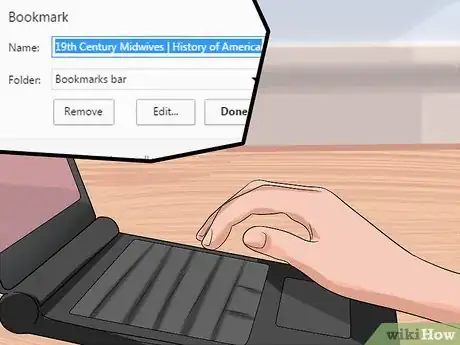





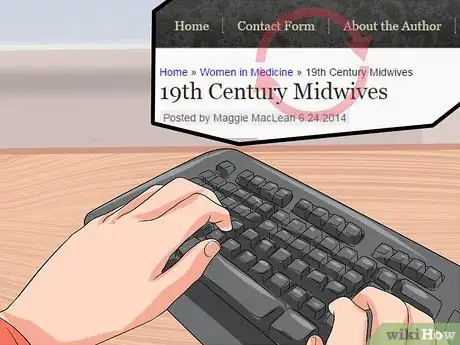


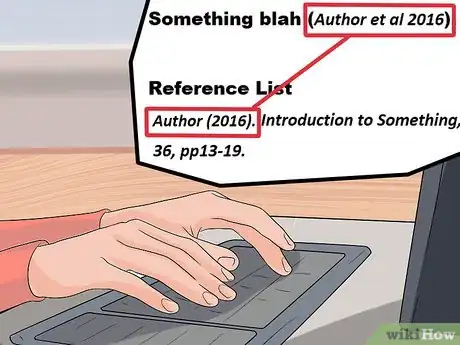



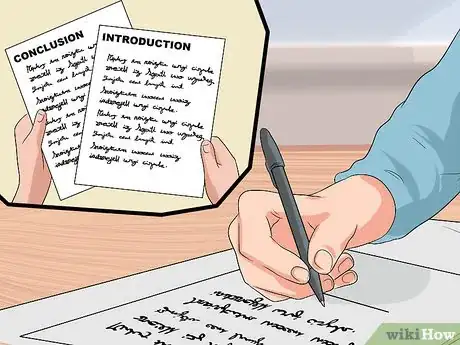

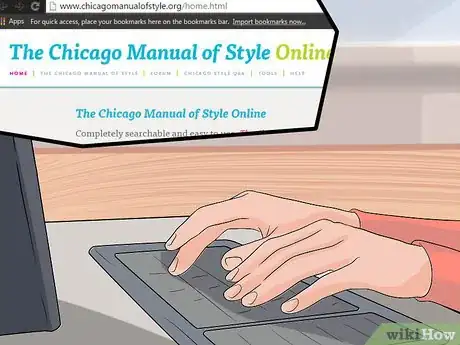



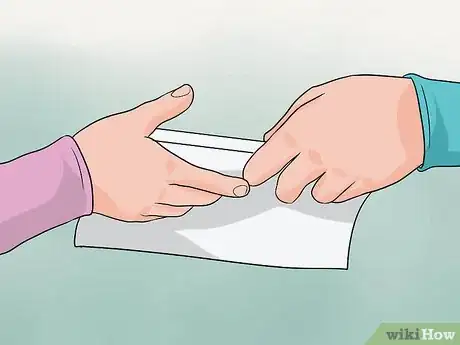





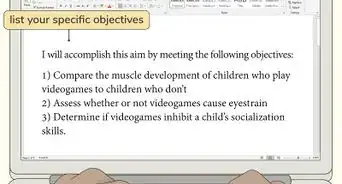













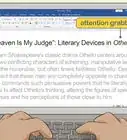


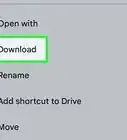




















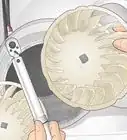













Medical Disclaimer
The content of this article is not intended to be a substitute for professional medical advice, examination, diagnosis, or treatment. You should always contact your doctor or other qualified healthcare professional before starting, changing, or stopping any kind of health treatment.
Read More...